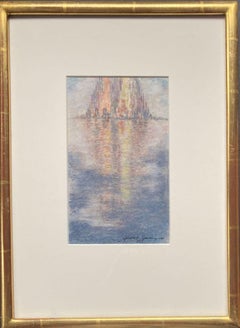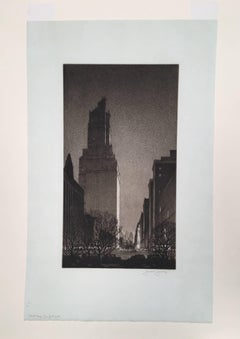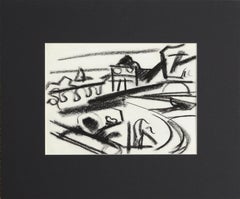Gerald Geerlings Art
American
Geerlings is best known for his lithographs and intaglio prints of the 1920s and 1930s. He was partly self-taught, although he studied periodically at the Royal College of Art in London between 1929 and 1932. His preferred subjects were the emerging metropolises of New York and Chicago in the 1920s and 1930s. He was awarded first prize for the best etching at the 'Century of Progress,' Chicago World's Fair of 1933 for Grand Canal, America, 1933. After his retirement from architectural practice in 1970, Geerlings devoted himself exclusively to drawing and lithography.
The images created by Gerald K. Geerlings provide not only a quality of technical achievement but also a visual delight matched by few of his contemporaries. Throughout his distinguished career as a decorated soldier, an accomplished architect and an artist of substantial artistic virtuosity, Gerald Geerlings has created an elegant legacy. As an artist, Geerlings is by no means prolific. His meticulous working method is readily apparent in either his stunning aquatints of the 1920s through 1930s or delicate pastels from 1970 and the 1980s. Fewer than sixty prints in several mediums were created between 1926 to 1933 and 1975 to 1988.
The images created by Gerald K. Geerlings provide not only a quality of technical achievement but also a visual delight matched by few of his contemporaries. Throughout his distinguished career as a decorated soldier, an accomplished architect, and an artist of substantial artistic virtuosity, Gerald Geerlings has created an elegant legacy(Biography provided by Allinson Gallery, Inc.)
to
2
1
1
1
Overall Height
to
Overall Width
to
1
1
1
1
2
1
3
6,952
3,302
2,514
1,213
1
1
1
Artist: Gerald Geerlings
Cityscape Reflections - Study No. 1
By Gerald Geerlings
Located in Storrs, CT
Cityscape Reflections - Misty Morning. 1980. Lithograph with pastel coloring. Czestochowski 42. Edition 40. 14 x 10 3/16 (sheet 18 x 14). Tape stains in the margins, not affecting th...
Category
Late 20th Century American Modern Gerald Geerlings Art
Materials
Pastel
Black Magic
By Gerald Geerlings
Located in New York, NY
Gerald Geerlings (1897-1998), Black Magic, etching and aquatint, 1929, signed in pencil lower right, titled and annotated (New York, 1928) lower left margi...
Category
1920s American Impressionist Gerald Geerlings Art
Materials
Etching
Related Items
Mid Century Abstracted San Francisco Bay Line Drawing Landscape
By Erle Loran
Located in Soquel, CA
Bold abstract geometric landscape, an expressive black and white line drawing done in pastel, by Erle Loran (American, 1905-1999). Unsigned, but was acquired from the artist's estate. Presented in a new black mat with foam core backing. Provenance: Estate of Earle Loran; David Carlson...
Category
Mid-20th Century Abstract Geometric Gerald Geerlings Art
Materials
Paper, Pastel
H 15 in W 18 in D 0.25 in
Rainstorm Sunset
By Robert Noel Blair
Located in Buffalo, NY
You are viewing a modernist American watercolor painting by Robert Noel Blair.
Robert Noel Blair (American, 1912-2003) was an American artist, painter, sculptor, printmaker and te...
Category
American Modern Gerald Geerlings Art
Materials
Paper, Watercolor
St. Paul's Church (St. Paul's Chapel, New York City)
By Bror Julius Olsson Nordfeldt
Located in Myrtle Beach, SC
B.J.O. Nordfeldt, 'St. Paul's Church' (St. Pauls' Chapel), etching, edition not stated, c. 1915. Signed in pencil. A superb, richly-inked impression, with skillfully controlled plate tone, printed on off-white, antique, laid paper; the full sheet with margins (5/8 to 2 1/4 inches), in very good condition. Scarce. Matted to museum standards, unframed.
An impression of this work is in the permanent collection of the Smithsonian American Art Museum.
ABOUT THE ARTIST
A solo exhibition of Nordfeldt’s etchings and woodcuts was presented by the Smithsonian Institution in 1926. In 1920, Nordfeldt had a one-man show at the Chicago Arts Club. In 1926, he won the bronze medal at the sesquicentennial exposition in Philadelphia and the Logan Medal at the Art Institute of Chicago. In 1927, he won the first annual prize from the Brooklyn Society of Etchers, and the following year he won first prize from the Chicago Society of Etchers. In 1929, Nordfeldt had a one-man show at the Denver Art Museum. Nordfeldt's work is held in numerous museum collections including Amon Carter Museum of Western Art, Ft. Worth; Anschutz Collection, Denver; Art Institute of Chicago; Biblioteque d’Art et d’Archeologie, Paris; British Museum, London; Corcoran Gallery of Art, Washington, DC; Los Angeles County Museum; Metropolitan Museum of Art, New York City; Museum of Fine Arts, Santa Fe; National Museum of American Art, Smithsonian Institution, Washington, DC; National Gallery, Sydney, Australia; Phillips Collection, Washington, DC.
ABOUT ST. PAUL'S CHAPEL
St. Paul's Chapel, nicknamed "The Little Chapel That Stood", is an Episcopal chapel located at 209 Broadway, between Fulton Street and Vesey Street, in Lower Manhattan, New York City. Built in 1766, it is the oldest surviving church building in Manhattan, and one of the nation's finest examples of Late Georgian church architecture. It is a New York City Landmark and a National Historic Landmark.
The Hearts of Oak, a militia unit organized early in the American Revolutionary War, and composed in part of King's College (later, Columbia University) students, would drill in the Chapel's yard before classes nearby. Alexander Hamilton was an officer of this unit. The chapel survived the Great New York City Fire of 1776 when a quarter of New York City (then confined to the lower tip of Manhattan), including Trinity Church, burned following the British capture of the city after the Battle of Long Island during the American Revolutionary War. George Washington, along with members of the United States Congress, worshipped at St. Paul's Chapel on his Inauguration Day, April 30, 1789. Washington also attended services at St. Paul's during the two years New York City was the country's capital. Above Washington's pew is an 18th-century oil painting of the Great Seal of the United States, adopted in 1782.
The rear of St. Paul's Chapel faces Church Street, opposite the east side of the World Trade Center site. After the attacks on September 11, 2001, which led to the collapse of the twin towers of the World Trade Center, St. Paul's Chapel served as a place of rest and refuge for recovery workers at the WTC site. For eight months, hundreds of volunteers worked 12-hour shifts around the clock, serving meals, making beds, counseling and praying with firefighters, construction workers, police, and others. Massage therapists, chiropractors, podiatrists, and musicians also tended to their needs.
The church survived without even a broken window. Church history declares it was spared by a miracle sycamore on the northwest corner of the property that was hit by debris. The tree's root has been preserved in a bronze memorial...
Category
1910s American Impressionist Gerald Geerlings Art
Materials
Etching
Shipping
By Kerr Eby
Located in Myrtle Beach, SC
Kerr Eby 'Shipping' also 'Shipping, Connecticut', etching and sandpaper ground, 1932, edition 100, Giardina 171. Signed in pencil and titled 'Shipping' in the bottom left sheet edge. A superb, atmospheric impression, with skillfully controlled plate tone, on heavy, cream wove paper; the full sheet with wide margins (2 to 2 3/4 inches), in excellent condition. Matted to museum standards, unframed.
Image size 8 3/8 x 17 1/4 inches (316 x 176 mm); sheet size 13 7/16 x 8 3/8 inches (341 x 213 mm).
The scene depicted was on the Connecticut coast...
Category
1940s American Impressionist Gerald Geerlings Art
Materials
Etching
Georgetown (Church in the Mountains, Colorado), Modernist Landscape Ink Drawing
By Charles Ragland Bunnell
Located in Denver, CO
Georgetown, Colorado, vintage 1938 WPA era ink drawing/painting on paper of a church set in a rocky mountain landscape by Charles Bunnell (1897-1968). Black on a creamy white paper, signed and dated lower right, titled lower left. Presented in a custom frame with all archival materials, outer dimensions measure 16 ¼ x 14 ½ x 1¼ inches. Image size is 7 ¾ x 5 ¾ inches.
Drawing is clean and in good vintage condition - please contact us for a detailed condition report.
Provenance: Estate of Charles Ragland Bunnell
Expedited and international shipping is available - please contact us for a quote.
About the Artist:
Charles Bunnell developed a love for art as a child in Kansas City, Missouri. Around 1915, Bunnell moved with his family to Colorado Springs, Colorado.
He served in World War I and later used his GI Training to study at the Broadmoor Art Academy (later renamed the Colorado Springs Fine Arts Center) during 1922 and 1923. In 1922, he married fellow student, Laura Palmer...
Category
1930s American Modern Gerald Geerlings Art
Materials
Ink, Archival Paper
H 16.25 in W 14.5 in D 1.25 in
1930s American Farm Scene, Landscape Watercolor Painting Farm Buildings Windmill
By Samuel Bolton Colburn
Located in Denver, CO
Original watercolor on paper painting by Samuel Bolton Colburn (1909-1993) of a small farm situated in a valley near the mountains. Presented in a custom frame, outer dimensions meas...
Category
1930s American Modern Gerald Geerlings Art
Materials
Paper, Watercolor
'Ship Rock, New Mexico' —
By Albert Groll
Located in Myrtle Beach, SC
Albert Lorey Groll, 'Ship Rock, New Mexico', etching, c. 1910. Signed and titled in pencil. A fine, richly-inked impression on cream, wove paper, the full sheet with margins (1 to 1 3/8 inches); a slight paper defect in the center-left margin, away from the image, otherwise in excellent condition. Image size 7 7/8 x 10 inches (200 x 254 mm); sheet size 10 1/8 x 12 15/16 inches (257 x 329 mm). Scarce.
Provenance: Ex. collection Kennedy Galleries, in their original gallery mat with label attached.
ABOUT THE ARTIST
Albert Lorey Groll (1866-1910) was born in New York in 1866, the son of a pharmacist immigrant from Darmstadt, Germany. During his early years, he traveled to Europe to study at the Royal Academy of Fine Arts in Munich under Nicholas Gysis and Ludwig von Löfftz. He further pursued his studies in London and at the Royal Academy of Fine Arts in Antwerp, Belgium. Groll returned to New York in 1895 and moved from figure to landscape painting while expanding his interests to printmaking.
In 1904 Groll made the first of several trips to the American Southwest, traveling to Arizona with ethnographer Stewart Culin of the Brooklyn Museum. Later he went to New Mexico with his friend, the artist and illustrator William Robinson Leigh (see our 1stDibs listing no. LU53239015112 ). He focused on impressionistic scenes of Native American lands. The Laguna Pueblo people admired Groll's paintings, honoring him with the name "Chief Bald Head Eagle Eye."
Groll kept a studio in the Gainsborough Studios in Manhattan and won several awards for his work in Arizona and New York, including the Salmagundi Club Shaw Prize in 1904 and a gold medal at the Pennsylvania Academy of Fine Arts in 1906. He was also awarded the George Inness gold medal from the National Academy of Design in 1912 for his painting of Lake Louise in the Canadian Rockies.
In 1910 he was elected into the National Academy of Design and, in 1919, an associate member of the Taos Society...
Category
1910s American Impressionist Gerald Geerlings Art
Materials
Etching
UP TO THE WOOLWORTH
By Joseph Pennell
Located in Santa Monica, CA
JOSEPH PENNELL (1857- 1926)
UP TO THE WOOLWORTH 1915 (Wuerth 673)
Etching, signed in pencil. Early state before additional work, especially before extensive darkening in the sky. I...
Category
1910s American Impressionist Gerald Geerlings Art
Materials
Etching
The Church Across the Way
By Childe Hassam
Located in Storrs, CT
The Church Across the Way. 1916. Etching. Cortissoz, Clayton 66. 8 1/4 x 4 3/8 (sheet 10 1/16 x 6 1/8). A fine impression with carefully-wiped plate tone printed on white laid paper ...
Category
1910s American Impressionist Gerald Geerlings Art
Materials
Etching
Broad Street (Wall Street)
By Bror Julius Olsson Nordfeldt
Located in Myrtle Beach, SC
B.J.O. Nordfeldt, 'Broad Street (Wall Street)', etching, edition not stated, c. 1915. Signed in pencil. A superb impression, with rich burr, selectively wiped plate tone, and inky plate edges, on cream wove paper; the full sheet with margins (3/4 to 1 1/4 inches), in excellent condition. Printed by the artist. Matted to museum standards, unframed.
Impressions of this work are in the permanent collections of the Fine Arts Museums of San Francisco, Princeton University, Smithsonian American Art Museum.
A view looking down Broad Street past the New York Stock Exchange Building on the right with the columned Federal Hall...
Category
1910s American Impressionist Gerald Geerlings Art
Materials
Etching
"Chimneys at Dusk", Small Pastel San Francisco Abstract Urban Landscape
Located in Soquel, CA
Abstracted Bay Area skyline against a pink sunset creates beautiful and soft geometries in this small pastel urban landscape by San Francisco artist Chris Cacciotti (American, 20th C...
Category
1990s Abstract Impressionist Gerald Geerlings Art
Materials
Paper, Pastel, Watercolor
H 16.5 in W 17.13 in D 0.75 in
Modernist Abstract Expressionist Watercolor Painting Bauhaus Weimar Pawel Kontny
By Pawel Kontny
Located in Surfside, FL
Abstract watercolor composition bearing the influence of the earlier color-block compositions of Paul Klee.
Pawel August Kontny, (Polish-German-American artist) He was born in Laurahuette, Poland, in 1923, the son of a wealthy pastry shop owner. In 1939 he began studying architecture in Breslau where he was introduced to the European masters and to the work of some of the German Expressionists, soon afterward banned as "degenerate artists" and removed from museums throughout Germany by the Nazi regime. His studies were interrupted by World War II. Drafted into the German army, traveling in many countries as a soldier, he sketched various landscapes but in 1945, he was captured and held as a prisoner of war in Italy. After the war, he studied at the Union of Nuremberg Architects to help design buildings to replace ones destroyed in the war. He recorded his impressions of the local population and the landscapes through his watercolors and drawings. Pawel Kontny thereafter moved to Nuremberg, Germany, becoming a member of the Union of Nuremberg Architects and helping to rebuild the city's historic center. He soon decided to concentrate on his professional art career. He married Irmgard Laurer, a dancer with the Nuremberg Opera. Pavel Kontny 's career as an artist was launched with his participation in an all German exhibition, held at the Dusseldorf Museum in 1952. He held one-man shows in Germany, Switzerland and the United States. During his trip to the United States in 1960, Kontny became instantly enamored with Colorado, and decided to relocate to Cherry Hills with his wife and two children. He quickly established himself in the local art community, being affiliated for a time with Denver Art Galleries and Saks Galleries. His subject matter became the Southwest. During this time he received the Prestigious Gold Medal of the Art Academy of Rome. His extensive travel provided material for the paintings he did using his hallmark marble dust technique. he also worked equally in pastel, watercolor, charcoal and pencil-and-ink. in a style which merged abstraction and realist styles, influenced by Abstract Expressionist painting and South Western American landscapes. This one bears the influence of Sam Francis. In the early 1960s he was one of only a few European-born professional artists in the state, a select group that included Herbert Bayer (1900-1985), a member of the prewar Bauhaus in Weimar and Dessau, Germany, and Roland Detre (1903-2001), a Hungarian modernist painter. As a Denver, Colorado resident, Pavel Kontny exhibited at galleries and museums throughout the United States, Germany and Japan. There, he was inspired by frequent trips to Native American pueblos in the Southwest, as well as by the study of the Plains Indians of Montana and Wyoming. Over the years Kontny had a number of students and generously helped young artist by hosting exhibitions at his Cherry Hills home. For many years he generously donated his paintings to support charitable causes in Denver. Influences during his European years included German pastelist C.O. Muller, German Informel painter Karl Dahmen and Swiss artist, Hans Erni. In the early 1950s his painting style showed the influence of the Die Brücke (The Bridge), a group of German expressionist artists formed in Dresden in 1905 who had a major impact on the evolution of modern art in the twentieth century in Germany. By the middle of the decade his style incorporated more referential abstraction and total abstraction, resulting in part from his study of Hans Hartung, a German artist based in Paris who exhibited his gestural abstract work in Germany. The American moon landing in 1969 inspired Paul Kontny...
Category
20th Century American Modern Gerald Geerlings Art
Materials
Watercolor, Archival Paper
Gerald Geerlings art for sale on 1stDibs.
Find a wide variety of authentic Gerald Geerlings art available for sale on 1stDibs. You can also browse by medium to find art by Gerald Geerlings in acrylic paint, crayon, drypoint and more. Much of the original work by this artist or collective was created during the 20th century and is mostly associated with the modern style. Not every interior allows for large Gerald Geerlings art, so small editions measuring 9 inches across are available. Customers who are interested in this artist might also find the work of Walter Tittle, Frank Weston Benson, and George G. Adomeit. Gerald Geerlings art prices can differ depending upon medium, time period and other attributes. On 1stDibs, the price for these items starts at $1,750 and tops out at $9,500, while the average work can sell for $2,750.


